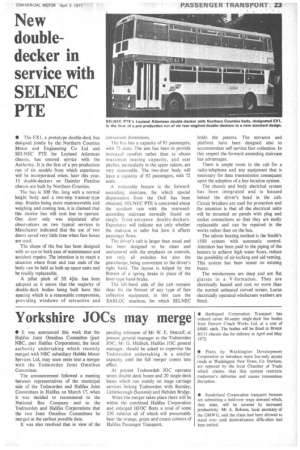New
Page 25

If you've noticed an error in this article please click here to report it so we can fix it.
double
decker in service with SELNEC PTE
• The EX1, a prototype double-deck bus designed jointly by the Northern Counties Motor and Engineering Co Ltd and SELNEC PTE for Leyland Atlantean chassis, has entered service with the Authority. It is the first of a pre-production run of six models from which experience will he incorporated when, later this year, 15 double-deckers on Daimler Fleetline chassis are built by Northern Counties.
The bus is 30ft 9in. long with a normal height body and a two-step tramcar-type step. Besides being more manoeuvrable and weighing and costing less, it is claimed that this shorter bus will cost less to operate. One door only was stipulated after observations on two typical services in Manchester indicated that the use of two doors saved very little time when fare boxes are used.
The shape of the bus has been designed with an eye to both ease of maintenance and accident repairs. The intention is to reach a situation where front and rear ends of the body can be held as built-up spare units and be readily replaceable.
A pillar pitch of 5ft 4in. has been adopted as it seems that the majority of double-deck bodies being built have this spacing which is a reasonable compromise, providing windows of attractive and
convenient dimensions.
The bus has a capacity of 95 passengers, with 75 seats. The aim has been to provide increased comfort rather than to obtain maximum seating capacity, and seat pitches, particularly in the upper saloon, are very reasonable. The two-door body will have a capacity of 92 passengers, with 72 seats.
A noticeable feature is the forwardascending staircase, for which special dispensation from the DoE has been obtained. SELNEC PTE is concerned about the accident rate with the rearwardascending staircase normally found on single front-entrance double-deckers. Experience will indicate not only whether the staircase is safer but how it affects passenger flows.
The driver's cab is larger than usual and has been designed to be clean and uncluttered with the emphasis on controls, not only all switches but also the gearchange, being convenient to the driver's right hand. The layout is helped by the fitment of a spring brake in place of the lever-type hand-brake.
The left-hand side of the cab remains clear for the fitment of any type of fare collection equipment, in this case the SABLOC machine, for which SELNEC
holds the patents. The entrance and platform have been designed also to accommodate self-service fare collection. In this respect the forward-ascending staircase has advantages.
There is ample room in the cab for a radio-telephone and any equipment that is necessary for data transmission consequent upon the adoption of a bus location system.
The chassis and body electrical system has been integrated and is housed behind the driver's head in the cab. Circuit breakers are used for protection and the intention is that all the electrical units will be mounted on panels with plug and socket connections so that they are easily replaceable and can be repaired in the works rather than on the bus.
The saloon heating method is the Smith's 1500 system with automatic control. Attention has been paid to the piping of the heaters to achieve high water flows, reduce the possibility of air-locking and aid venting. This system has been tested on existing buses.
The windscreens are deep and are flat glasses in a V-formation. They are electrically heated and cost no more than the .normal unheated curved screen. Lucas electrically operated windscreen washers are fitted.




























































































